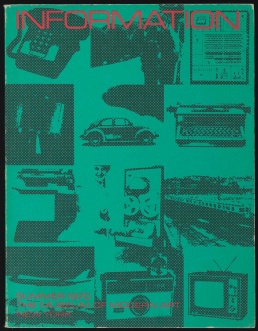Difference between revisions of "Information (1970 exhibition)"
| Line 1: | Line 1: | ||
| − | [[Kynaston McShine]] | + | [[Image:Information_1970_catalog.jpg|thumb|258px|Catalogue cover.]] |
| + | An exhibition curated by [[Kynaston McShine]] and held at MoMA in [[New York City|New York]] between 2 July and 20 September 1970. | ||
| + | |||
| + | The exhibition presented videos and installations by 100 American and European artists (e.g. [[Vito Acconci]], [[Art & Language]], [[Daniel Buren]], [[Jan Dibbets]], [[Hans Haacke]], [[Dennis Oppenheim]], [[Edward Ruscha]], [[Robert Smithson]], or [[Jeff Wall]]). It included an early example of dealing with publicly accessible archives within the context of an exhibition and some of the participating artists confronted the issues of political and media based contents: Haacke established ''MOMA POLL'' as a first link between the areas of politics and the museum by presenting an open poll on the way the Rockefeller family acted with regard to Nixon's plans in Indochina. | ||
<blockquote>"With an artworld that knows more readily about current work, through reproductions and the wide dissemination of information via periodicals, and that has been altered by television, films and satellites, as well as the “jet,” it is now possible for artists to be truly international; exchange with their peers is now comparatively simple. The art historian’s problem of who did what fi rst is almost getting to the point of having to date by the hour. Increasingly artists use mail, telegrams, telex machines, etc., for transmission of works themselves—photographs, fi lms, documents—or of information about their activity. For both artists and their public it is a stimulating and open situation, and certainly less parochial than even fi ve years ago.It is no longer imperative for an artist to be in Paris or New York. Those far from the “art centers” contribute more easily, without the ooften artifi cial protocol that at one time seemed essential for recognition."<br> | <blockquote>"With an artworld that knows more readily about current work, through reproductions and the wide dissemination of information via periodicals, and that has been altered by television, films and satellites, as well as the “jet,” it is now possible for artists to be truly international; exchange with their peers is now comparatively simple. The art historian’s problem of who did what fi rst is almost getting to the point of having to date by the hour. Increasingly artists use mail, telegrams, telex machines, etc., for transmission of works themselves—photographs, fi lms, documents—or of information about their activity. For both artists and their public it is a stimulating and open situation, and certainly less parochial than even fi ve years ago.It is no longer imperative for an artist to be in Paris or New York. Those far from the “art centers” contribute more easily, without the ooften artifi cial protocol that at one time seemed essential for recognition."<br> | ||
| − | source: Kynaston McShine, "Introduction to Information", | + | (source: Kynaston McShine, "Introduction to Information", in the catalogue)</blockquote> |
| − | ; | + | ; Literature |
| + | * [http://adkp.ruhe.ru/sites/default/files/0104.pdf "Information / 02.07. – 20.09.1970, Museum of Modern Art, New York"], ''Displayer'' 1, pp 31-40. | ||
| + | * Adam Lauder, [http://spectrum.library.concordia.ca/6900/1/Lauder_MA_F2010.pdf ''Executive Fictions: Revisiting'' Information], Montreal: Concordia University, 2010. Master's thesis. | ||
| + | |||
| + | ; Links | ||
* http://www.moma.org/research/archives/EAD/InfoExhibitionRecordsf.html | * http://www.moma.org/research/archives/EAD/InfoExhibitionRecordsf.html | ||
* [http://www.moma.org/docs/press_archives/4484/releases/MOMA_1970_July-December_0004a_69D.pdf?2010 MOMA press release] | * [http://www.moma.org/docs/press_archives/4484/releases/MOMA_1970_July-December_0004a_69D.pdf?2010 MOMA press release] | ||
| − | + | ||
| + | [[Category:Conceptual art]] | ||
Revision as of 11:53, 25 November 2014
An exhibition curated by Kynaston McShine and held at MoMA in New York between 2 July and 20 September 1970.
The exhibition presented videos and installations by 100 American and European artists (e.g. Vito Acconci, Art & Language, Daniel Buren, Jan Dibbets, Hans Haacke, Dennis Oppenheim, Edward Ruscha, Robert Smithson, or Jeff Wall). It included an early example of dealing with publicly accessible archives within the context of an exhibition and some of the participating artists confronted the issues of political and media based contents: Haacke established MOMA POLL as a first link between the areas of politics and the museum by presenting an open poll on the way the Rockefeller family acted with regard to Nixon's plans in Indochina.
"With an artworld that knows more readily about current work, through reproductions and the wide dissemination of information via periodicals, and that has been altered by television, films and satellites, as well as the “jet,” it is now possible for artists to be truly international; exchange with their peers is now comparatively simple. The art historian’s problem of who did what fi rst is almost getting to the point of having to date by the hour. Increasingly artists use mail, telegrams, telex machines, etc., for transmission of works themselves—photographs, fi lms, documents—or of information about their activity. For both artists and their public it is a stimulating and open situation, and certainly less parochial than even fi ve years ago.It is no longer imperative for an artist to be in Paris or New York. Those far from the “art centers” contribute more easily, without the ooften artifi cial protocol that at one time seemed essential for recognition."
(source: Kynaston McShine, "Introduction to Information", in the catalogue)
- Literature
- "Information / 02.07. – 20.09.1970, Museum of Modern Art, New York", Displayer 1, pp 31-40.
- Adam Lauder, Executive Fictions: Revisiting Information, Montreal: Concordia University, 2010. Master's thesis.
- Links
